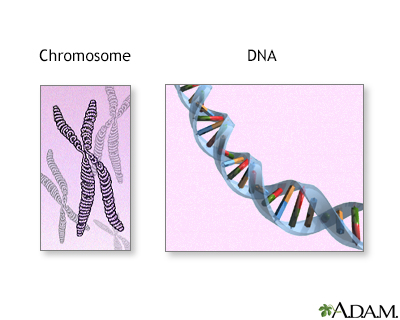Pregnancy SmartSiteTM
DefinitionXeroderma pigmentosum (XP) is a rare condition passed down through families. XP causes the skin and tissue covering the eye to be extremely sensitive to ultraviolet (UV) light. Some people also develop nervous system problems. CausesXP is an autosomal recessive inherited disorder. This means you must have 2 copies of an abnormal gene in order for the disease or trait to develop. The disorder is inherited from both your mother and father at the same time. The abnormal gene is rare, so the chances of both parents having the gene are very rare. For this reason, it is unlikely for somebody with the condition to pass it on to the next generation, although it is possible. UV light, such as from sunlight, damages the genetic material (DNA) in skin cells. Normally, the body repairs this damage. But in people with XP, the body does not fix the damage. As a result, the skin gets very thin and patches of varying color (splotchy pigmentation) appear. SymptomsSymptoms usually appear by the time a child is 2 years old. Skin symptoms include:
Eye symptoms include:
Nervous system (neurologic) symptoms, which develop in some children, include:
Exams and TestsThe health care provider will perform a physical exam, paying special attention to the skin and eyes. The provider will also ask about a family history of XP. Tests that may be done include:
The following tests can help diagnose the condition in a baby before birth:
TreatmentPeople with XP need total protection from sunlight. Even the light coming through windows or from fluorescent bulbs can be dangerous. When out in the sun, protective clothing must be worn. To protect the skin and eyes from the sunlight:
To prevent skin cancer, your provider may prescribe medicines, such as a retinoid cream, to apply to the skin. If skin cancer develops, surgery or other methods will be done to remove the cancer. Support GroupsMore information and support for people with XP and their families can be found at:
Outlook (Prognosis)Over one half of people with this condition die of skin cancer early in adulthood. When to Contact a Medical ProfessionalContact your provider for an appointment if you or your child has symptoms of XP. PreventionExperts recommend genetic counseling for people with a family history of XP who wish to have children. ReferencesBender NR, Chiu YE. Photosensitivity. In: Kliegman RM, St. Geme JW, Blum NJ, Shah SS, Tasker RC, Wilson KM, eds. Nelson Textbook of Pediatrics. 21st ed. Philadelphia, PA: Elsevier; 2020:chap 675. Patterson JW. Disorders of epidermal maturation and keratinization. In: Patterson JW, ed. Weedon's Skin Pathology. 5th ed. Philadelphia, PA: Elsevier; 2021:chap 10. | |
| |
Review Date: 5/31/2023 Reviewed By: Ramin Fathi, MD, FAAD, Director, Phoenix Surgical Dermatology Group, Phoenix, AZ. Also reviewed by David C. Dugdale, MD, Medical Director, Brenda Conaway, Editorial Director, and the A.D.A.M. Editorial team. The information provided herein should not be used during any medical emergency or for the diagnosis or treatment of any medical condition. A licensed medical professional should be consulted for diagnosis and treatment of any and all medical conditions. Links to other sites are provided for information only -- they do not constitute endorsements of those other sites. No warranty of any kind, either expressed or implied, is made as to the accuracy, reliability, timeliness, or correctness of any translations made by a third-party service of the information provided herein into any other language. © 1997- A.D.A.M., a business unit of Ebix, Inc. Any duplication or distribution of the information contained herein is strictly prohibited. | |

 Chromosomes and DN
Chromosomes and DN
